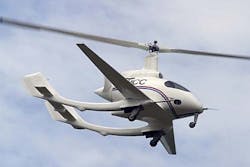DARPA program to launch long-range UAVs from small ships expands to five contractors
UAV experts from Carter Aviation Technologies LLC in Wichita Falls, Texas; Northrop Grumman Corp. in Arlington, Va.; and Aurora Flight Sciences Corp. in Manassas, Va., are the latest companies to join the Tactically Exploited Reconnaissance Node (TERN) program of the U.S. Defense Advanced Research Projects Agency (DARPA) in Arlington, Va.
The DARPA TERN program seeks to overcome limitations of Navy shipboard aircraft surveillance. Helicopters are relatively limited in their maximum distances and flight times, for example, while fixed-wing manned and unmanned aircraft must operate from aircraft carriers or large land bases with long runways, although they can fly farther and longer than helicopters.
Carter Aviation Technologies, Northrop Grumman, and Aurora Flight Sciences join AeroVironment Inc. in Monrovia, Calif., and Maritime Applied Physics Corp. (MAPC) in Baltimore on the initial phase of the TERN program. Carter won a $2.2 million TERN contract on 6 Sept., Northrop Grumman won a $2.9 million TERN contract on 6 Sept., while Aurora won a $2.8 million on 17 Sept. AeroVironment and MAPC won their TERN contracts in August.
In the first phase of the TERN program experts from the five companies will study designs for an operational TERN UAV, and plan for a prototype flight demonstration in 2017.
Carter Aviation Technologies is an aerospace research and development firm that developed Slowed-Rotor/Compound (SR/C) technology that couples the speed, range, and efficiency of an airplane with the vertical takeoff and landing capability of a helicopter. Carter's SR/C technology is scalable from very small UAVs to large transport aircraft.
For the TERN program Carter Aviation Technologies is offering a sea-based UAV with SR/C technology to enable long-range and long-endurance performance. Company officials say the expect significant challenges with recovering the UAV in heavy seas and bad weather.
Aurora Flight Sciences, meanwhile, produces the Centaur optionally piloted aircraft, the Orion long-endurance UAV, and the Skate small UAV that on first glance looks like a flying pizza box. Northrop Grumman is developing a carrier-based unmanned combat aerial vehicle.
The TERN program seeks to combine the strengths of aircraft bases on land and sea, by using small ships as mobile launch and recovery sites for medium-altitude long-endurance (MALE) fixed-wing UAVs, DARPA officials say.
The ultimate goal for a TERN UAV and launch system to enable persistent ISR and strike capabilities with payloads of 600 pounds while operating at ranges as long as 900 nautical miles from a host vessel.
The TERN system should be able to operate from several relatively small ship types in rough seas, including the 2,784-ton Independence-class littoral combat ship (LCS), which is 418 feet long and 104 feet wide, with a large aft-located flight deck. Other ships of interest are amphibious transport docks, dock landing ships, and Military Sealift Command cargo ships.
The program will produce a low-cost TERN prototype UAV to demonstrate launch, recovery, and enabling technologies.
DARPA plans to roll out TERN in three phases over three or four years, culminating in a full-scale launch and recovery demonstration. The first phase will include concept definition activities; the second phase will mature technology, with preliminary design; and the last phase will demonstrate a TERN prototype.
A second solicitation will be issued during the first phase of the program for TERN Phase II and III work.
From the TERN contractors, DARPA officials are interested in novel launch and recovery techniques; aircraft navigation; ship motion prediction; high lift devices; high stroke recovery or arrestment devices; and compact stowage arrangements. Other technologies of interest include automated maintenance systems; robotic deck handling; automated vehicle preflight checkout.
TERN envisions UAV systems for deep overland ISR and strike missions without forward basing or host nation help. Long radius of action enables access to remote geographic areas while long endurance enables persistent ISR and striking fleeting targets.
A relatively small ship deploying with two or more UAVs could offer high-tempo ISR and strike operations on an as-needed basis, DARPA officials say. The program does not involve helicopters or airships.
Named after the family of sea birds known for flight endurance, TERN aims to make it much easier, quicker and less expensive for the U.S. military to deploy ISR and strike aircraft almost anywhere in the world, DARPA officials say.
The TERN medium-altitude, long-endurance (MALE) UAV and automated launch-and-recovery system will be able to launch a 600-pound payload and fly as far as 600 to 900 nautical miles from its host vessel.
The TERN program envisions a capability "like having a falcon return to the arm of any person equipped to receive it, instead of to the same static perch every time,” says Daniel Patt, the DARPA TERN program manager.
"About 98 percent of the world’s land area lies within 900 nautical miles of ocean coastlines," Patt explains. "Enabling small ships to launch and retrieve long-endurance UAVs on demand would greatly expand our situational awareness and our ability to quickly and flexibly engage in hotspots over land or water.”
For more information contact Carter Aviation Technologies online at www.cartercopters.com, Aurora Flight Sciences at www.aurora.aero, AeroVironment at www.avinc.com, MAPC at www.mapcorp.com, or DARPA at www.darpa.mil.
